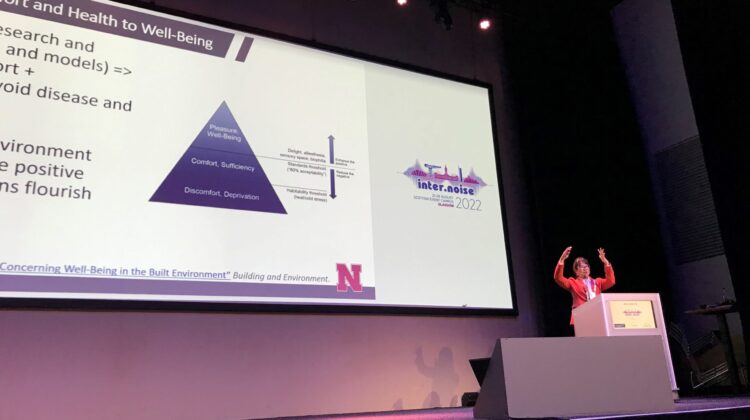
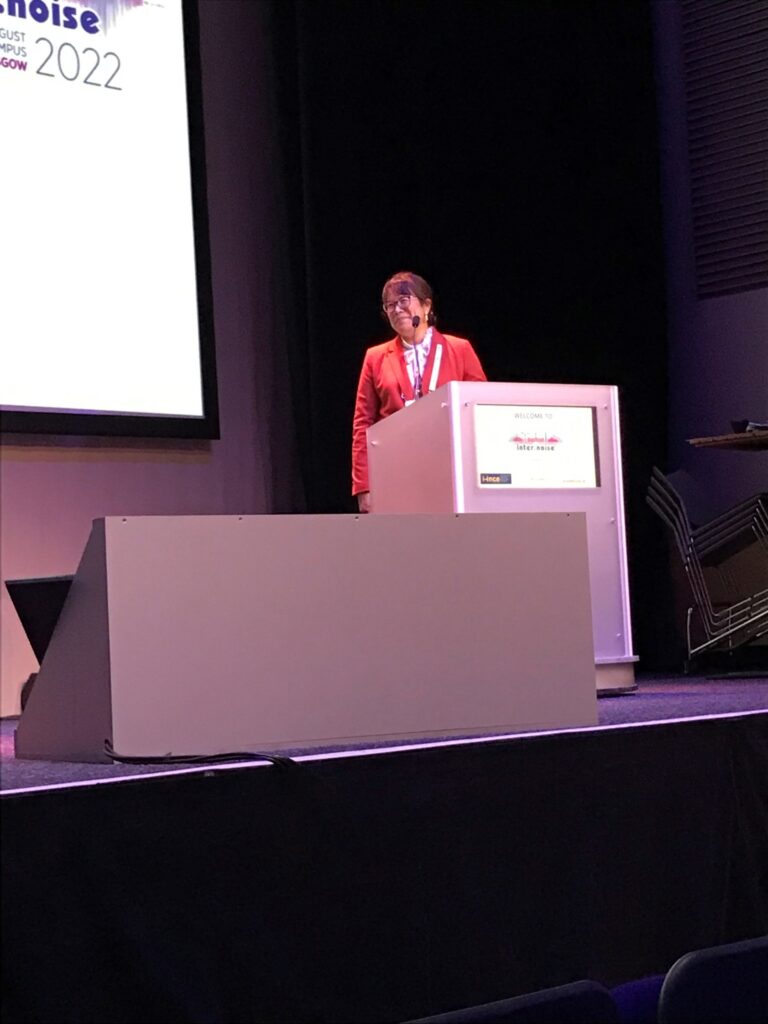 If Michael Jackson was King of Pop – Lily Wang is Queen of acoustics! We feel so lucky to have been part of a legendary keynote presentation that made us laugh, wonder, reflect, and a bit star-struck! Lily has skills that go beyond her impressive professional merits: This lady excels on stage! Add to that a kind person staying to answer all the questions from the long queue of people AND a smile that never seems to fade.
If Michael Jackson was King of Pop – Lily Wang is Queen of acoustics! We feel so lucky to have been part of a legendary keynote presentation that made us laugh, wonder, reflect, and a bit star-struck! Lily has skills that go beyond her impressive professional merits: This lady excels on stage! Add to that a kind person staying to answer all the questions from the long queue of people AND a smile that never seems to fade.
Under the title ‘Linking indoor acoustic conditions to human comfort and performance’ Lily guided us through three studies:
- Classroom acoustics study
- Speech comprehension study
- Restaurant study (will not be included in this summary)
Before she dug into her research she was kind to share her ‘original’ passion for sound – which was singing. Yes – Lily dreamt of being a singer (I would definitely have bought a ticket for your concerts, Lily!) and even if she has a good choir voice, as she went through high school it was the field of concert acoustics that hooked her.
Knowing that not all people would go to a concert hall on a regular basis – and that fundings often are hard to get (!), Lily chose to concentrate her work in other performance spaces for humans: offices, classrooms hospitals, restaurants, other. Lily pointed out that we spend 87% of our time indoors (Klepeis et al 2001) and that we know very well how acoustic conditions can have significant impacts on human comfort, health and performance.

In her introduction, Lily also went through how standards and guidelines often recommend upper limits for Reverberation Time (RT) and Background Noise Levels (BNL) and as an example ANSI S12.60-2010 part 1 states that RT: 0.6-0.7 sec. (max) and BNL: 35 dBA (max). But Lily misses something in the standards and therefore her research goal is clear: She works for more evidence-based data to guide the acoustic design of built spaces – and she explores how indoor acoustic conditions relate to human comfort and performance. Also Lily strives to inform quantitative guidelines for what is permissible/optimal.
Classroom Acoustics Study
Lily and her team have done a great and massive study including 220 classrooms in 5 local school districts.
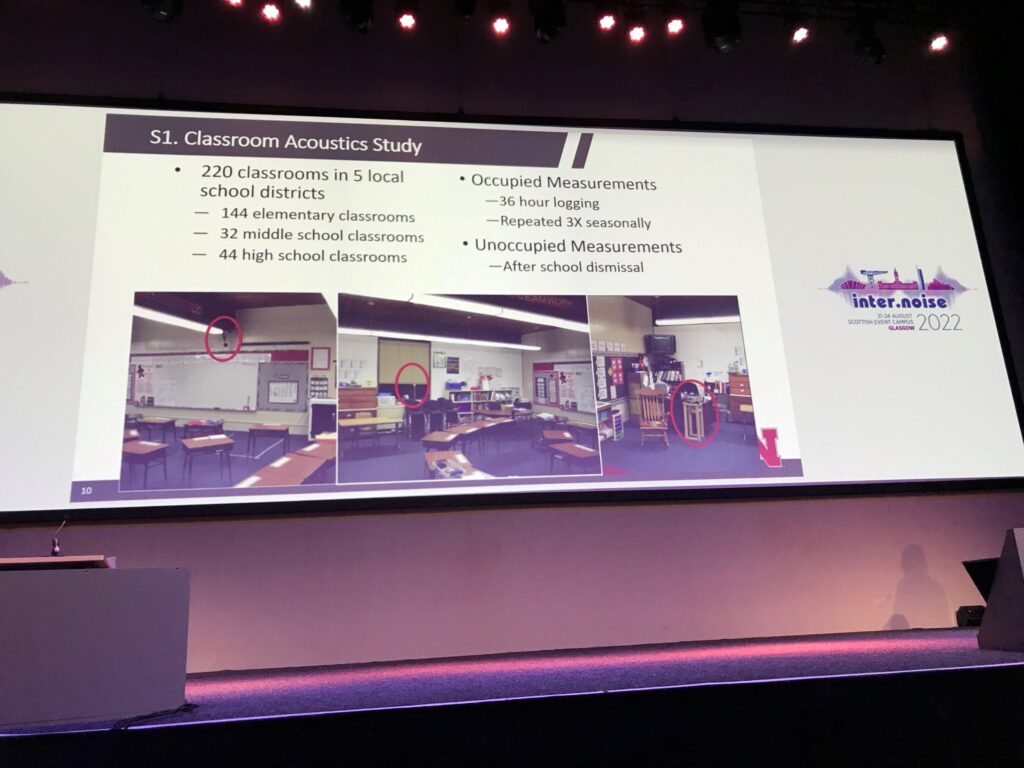
They investigated how do indoor environmental conditions in the school buildings impact students’ academic achievement and they learned – based on acoustic measurements: (RT, C50, background noise) that:
Unoccupied classroom standard for background noise were not met.
Speech was present about 50% of the time across grades looking into occupied levels (measured at 10s intervals) and even more in younger grades. The analysis split auditory data into speech and non-speech using k-means clustering. The team also investigated how often noise exceeds 50dBa – exceeds 60 dBa, the percentage of time exceeding 65 dBA, up to 70% of the day. Also – and very important, correlations with achievement were investigated (outcome variables: math and reading achievement) and the results showed that higher non-speech levels correlate with lower math achievement scores (p<0.01). No effects on reading.
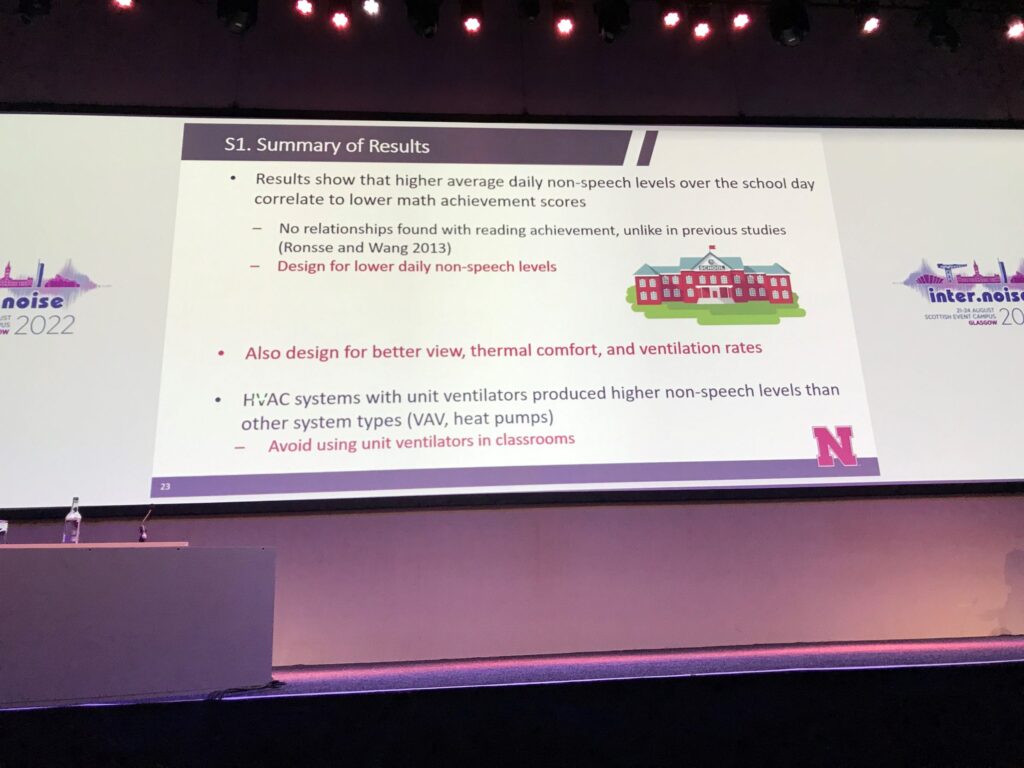
Lily concluded that what matters in a K-12 classroom is RT: less than 0.8 sec. IF you are lucky enough to be taught in your first language. Noise levels should be less than 40 dB.
Speech comprehension study
Growing up with Chinese as her first language, Lily herself was a second language learner (L2 learner). Today, 21% school children in the US are L2 learners. This study was based on speech comprehension tasks using Dual Task Scheme. Accuracy in % correct on task was measured and the design of the study tried to mimic what often takes place in a classroom setting: writing notes at the same time as one has to listen to the teacher.
An adaptive dot tracing task was developed as part of the dual task test (the student will with the dominant hand follow a dot round in a circle at the same time as the other hand will answer A, B, C or D to a question asked related to a picture). The task was concretely to see a picture and hear 4 sentences and match the one that best described the photo. Different RTs were presented (5 levels) and different basic noise levels (3 levels).
Results
Lily concluded that both noise level and RT affected the learners’ performance. There was also a correlation with background noise levels and level of English proficiency (L2 listeners performed much worse than L1) and the study revealed that for L2 learners to achieve the same levels of performance they needed lower noise levels (<40 dBA). and shorter RT (<0.6).
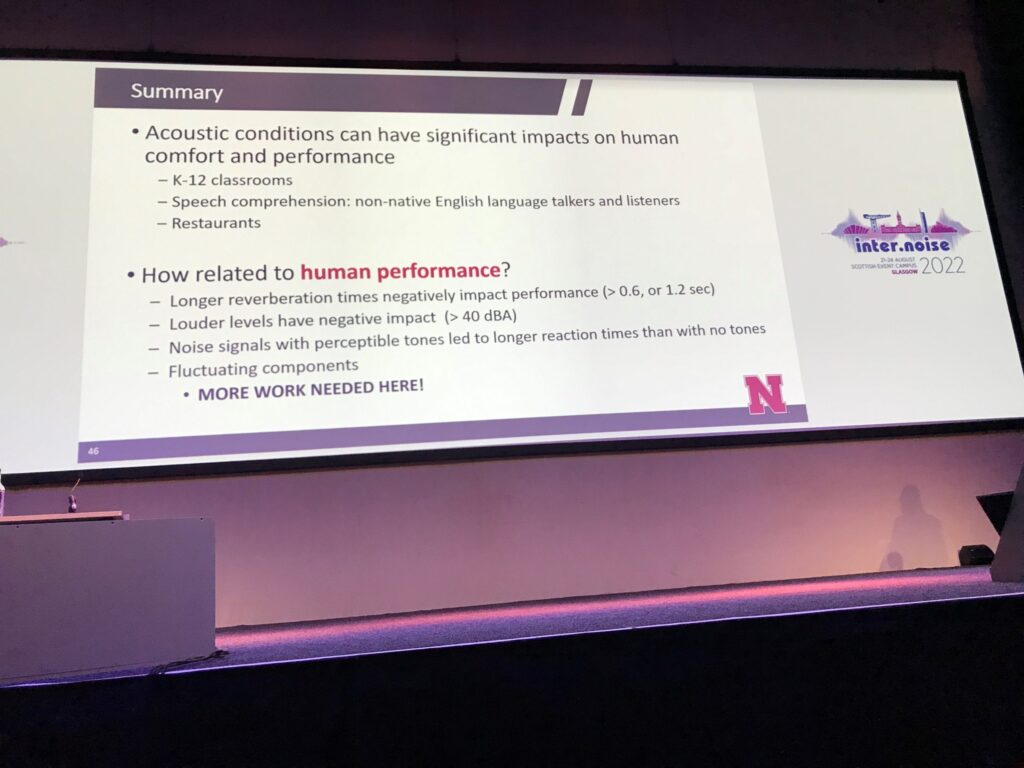
For a very long time the field of room acoustics have been focusing on comfort and health – on how to prevent stressors and limitations of harmful exposures at the same time as the individual perception of environmental conditions have been important. But Lily is on a quest! It is time to move towards well-being! She stated:
Moving from comfort and health to well-being means a shift from risk-avoidance towards a synergistic appreciation of the positive relationships between buildings and their occupants.
Like a Maslow’s hierarchy of needs a similar pyramid can be made for buildings. We of course need a discomfort/deprivation habitability threshold (heat/cold stress) and the next level will be a comfort/sufficiency standard threshold (corresponding to 80% acceptability. These two parts of the pyramid is said to reduce the negative. BUT – the top of the pyramid is the dedicated space for pleasure and well-being! The pyramid top is where delight, biophilia and sensory spaces are and the top should enhance the positive impact on humans.
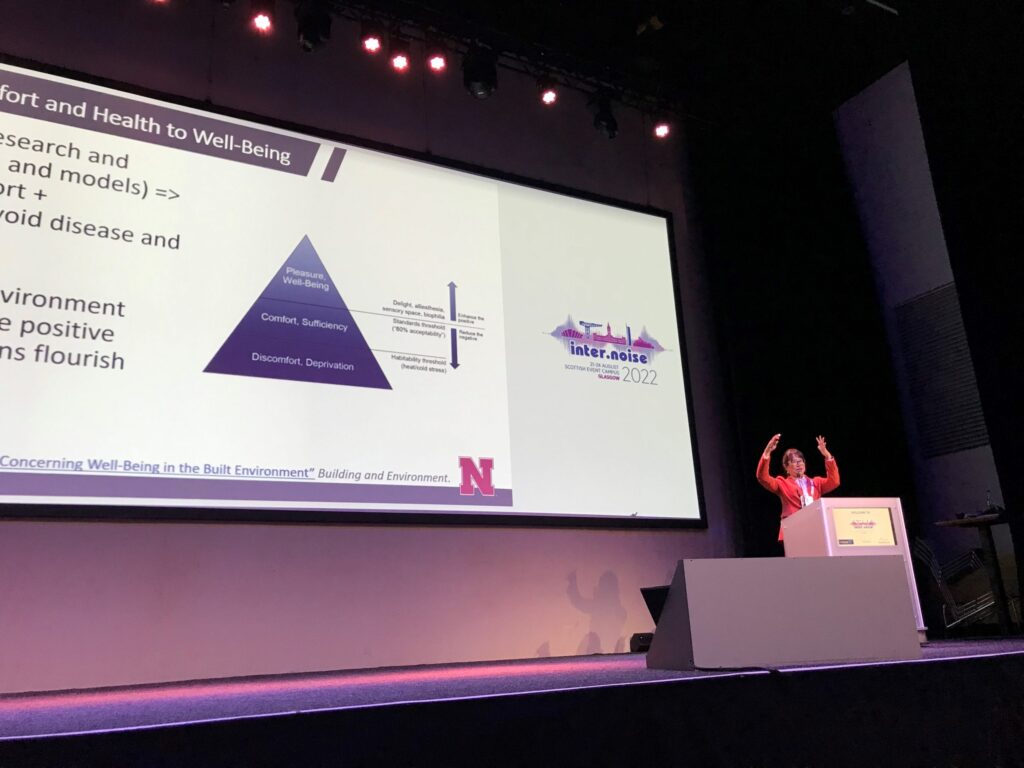
Dear Lily. You dream of setting guidelines and standards for designing indoor acoustic environments towards wellbeing – and we are with you all the way! Your presentation and your presence made Internoise memorable! Thank you. You are an impressive ambassador and a true crusader for good acoustics! YOU have a sound effect on people!
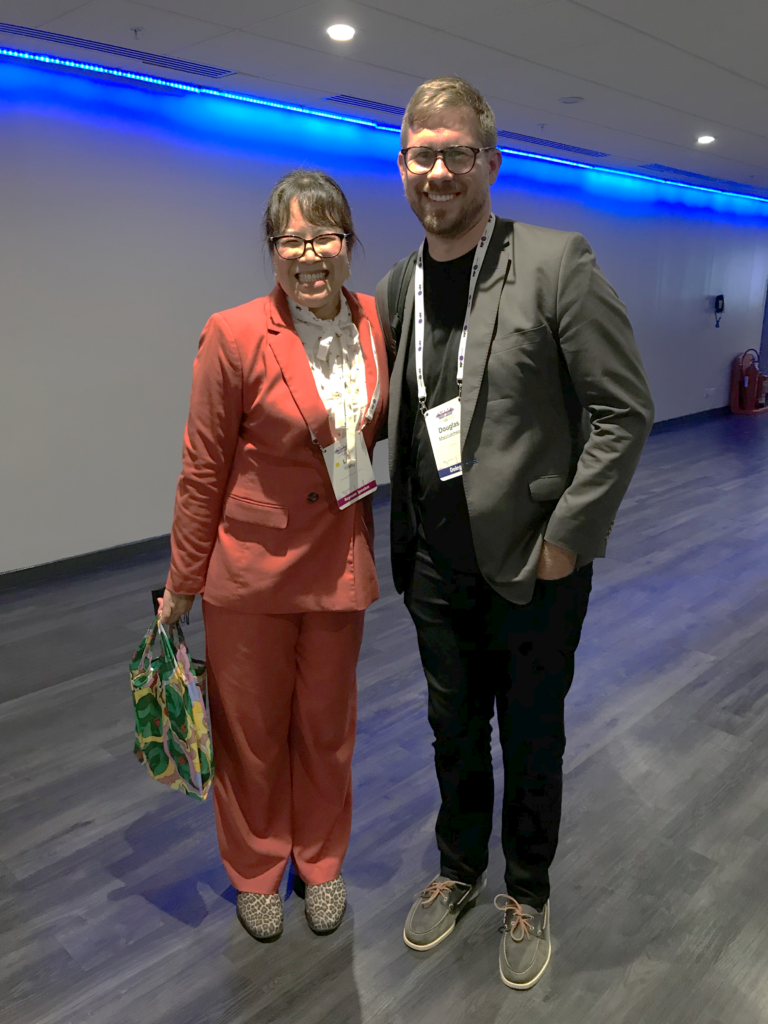
More than a decade ago we met Lily at EIAS – Ecophon International Acoustics Seminar for the first time – and this interview was made just after her presentation. Time flies – Lily’s passion and smile are the same!

